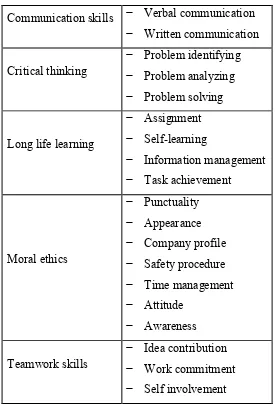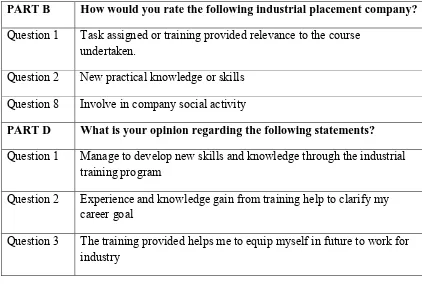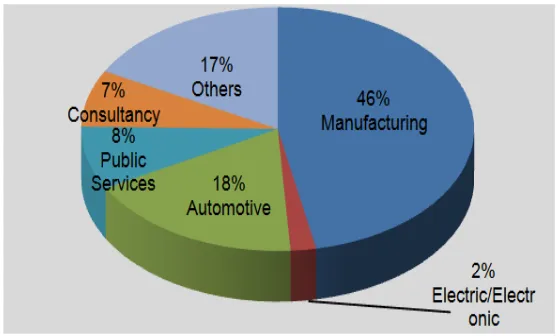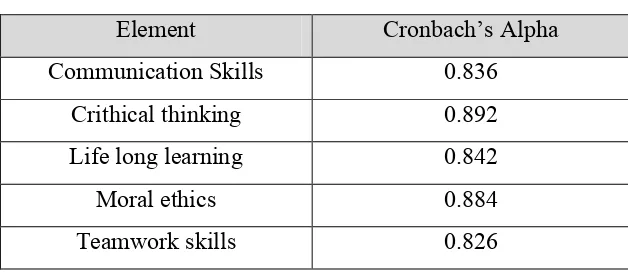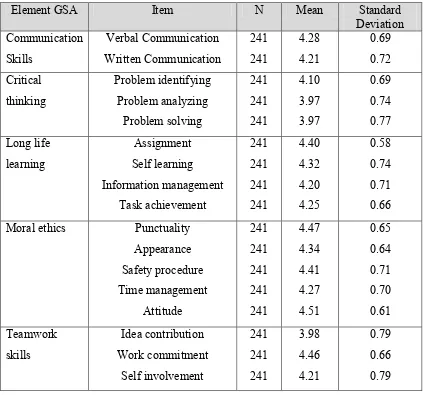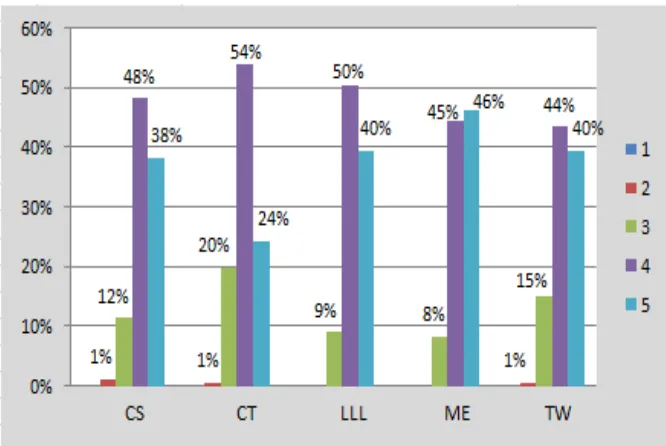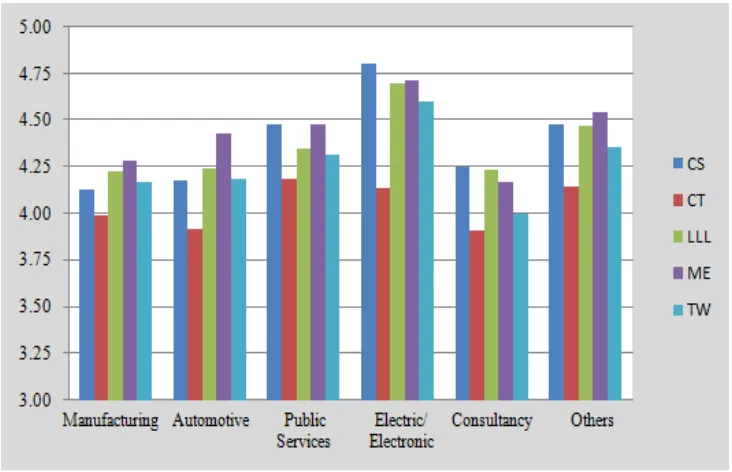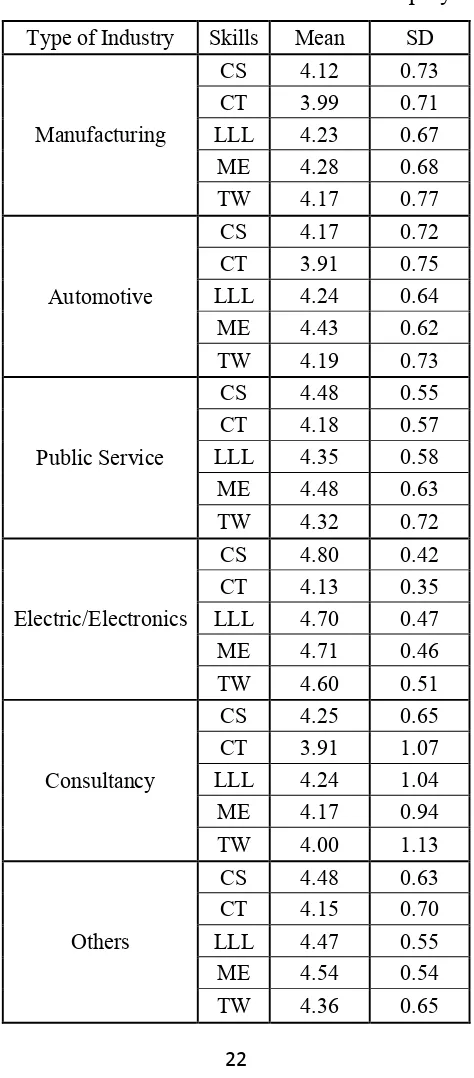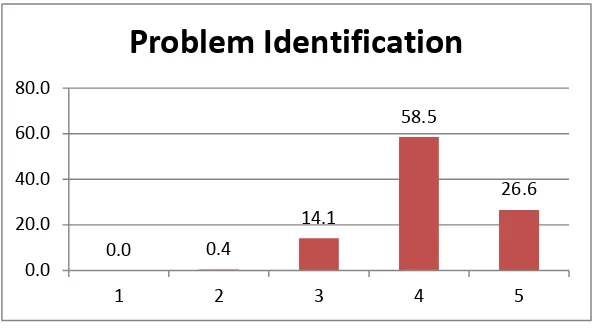PROJECT COMPLETION REPORT FOR
SHORT TERM RESEARCH GRANT
Principal Researcher : Mahanum Binti Mohd Zamberi (Sept 2012-Sept 2013) Nortazi Binti Sanusi ( July 2010 – August 2012)
Co-Researcher : 1. Ernie Binti Mat Tokit 2. Zakiah Binti Abd Halim 3. Mohd Azli Bin Salim
Project Code No : PJP/2010/FKM (20G)/ S734 Report Submission Date : 4 August 2013
FACULTY OF MECHANICAL ENGINEERING UNIVERSITY TEKNIKAL MALAYSIA MELAKA
ABSTRACT
THE IMPORTANCE OF INDUSTRIAL TRAINING PROGRAM TOWARDS STUDENTS HOLISTIC DEVELOPEMENT
The internship program that had been organized in FKM is adequately exposing the student to the real world of engineering. Being a ‘part-timer’ in industries, the students are being reinforced with the classroom and working experiences. A very high quality internship program is those that provide the students with multi task and know-how responsibilities. Today generic knowledge has been one of increasingly important issues that play an important role not only in higher learning institutions but also in industries. Sensitive and responsive towards this program by both company and academia will ensure that only quality experience to be imparted to students. The significant of this program had been addressed as a platform for the student to future plans their career by presenting themselves in professional atmosphere while building up their soft skills. Passionate and love about a career should be build within the students which will later motivate the student to grab as much valuable experience as needed. This study is concerning on the effectiveness of industrial training conducted by Faculty of Mechanical Engineering, Universiti Teknikal Malaysia Melaka. The quantitative methods were used to establish the difference between the faculty, students and company’s perception. This paper also discusses the importance of the generic student’s attributes and also some recommendations in respect of further works that can be very valuable to increase the internship program and the employability of mechanical engineering graduates as well.
KEYWORDS: Industrial training, Faculty of Mechanical Engineering, generic students attributes, employability, undergraduates.
Key Researchers:
Mahanum binti Mohd Zamberi (Head) Nortazi Binti Sanusi
ACKNOWLEDGEMENTS
First and foremost, the authors would like to acknowledge Universiti Teknikal Malaysia Melaka (UTeM) for providing the financial, administrative and logistic support for successfully conducting this short term research work. The authors would also like to extend their appreciation to people who have directly and indirectly involved in contributing the ideas, the top management of Faculty of Mechanical Engineering, lecturers, technicians and students.
iii
TABLE OF CONTENTS
4.1 Company perception on the employability skills of industrial training students
4.2 Student’s perception on the effectiveness of industrial training on developing generic students attributes 4.2.1 Critical Thinking
4.2.2 Moral and ethics 4.2.3 Communication Skills 4.2.4 Life Long Learning 4.2.5 Teamwork
4.3 Exploring the Importance of Industrial Training for Mechanical Engineering Undergraduates
LIST OF FIGURE
Figure No. Title Page
4.1 Trainees by Course and Gender 10
4.2 Trainees percentage by Company Type 11
4.3 Employers’ Rating by GSA 14
4.4 GSA’s Mean Score by Type of Industry 15
4.5 Problem Identification 18
4.6 Problem Analysis 18
4.7 Problem Solving 18
4.8 Personal Appearance 19
4.9 Punctuality 19
4.10 Company rules and regulations 20
4.11 Verbal communication 20
4.12 Written Communication 21
4.13 Work Assignment 21
4.14 Self Learning Capability 22
4.15 Information Management 22
4.16 Idea Contribution 22
4.17 Commitment 23
4.18 Task achievement 23
4.19 Respondents’ Opinion for Selected Items in Part D 29
v
LIST OF TABLE
Table No. Title Page
3.1 Items in Generic Student Attributes 9Gsa) Elemetns 8 3.2 Questions for Part B and D of Students Feedback after
completion of industrial Training
9
4.1 Reliability Analysis 12
4.2 Mean for Item in GSA Element 13
4.3 Mean for GSA Element 14
4.4 Mean Score for GSA Based Employers’ Yype 16
4.5 Reliability Statistics 17
4.6 Reliability Analysis 24
4.7 Frequency Satisfactory Level for D1 and Selected Questions from Part B
25
4.8 Frequency Satisfactory Level for D2 and Selected Questions from Part B
25
4.9
4.10 4.11
Frequency Satisfactory Level for D3 and Selected Questions from Part B
Test Statistics by using Kruskal Wallis test
The mean and standard deviation for Selected Items in Part B and Part D
26
27 30
vi
CHAPTER 1
THE IMPORTANCE OF INDUSTRIAL TRAINING PROGRAM TOWARDS STUDENTS HOLISTIC DEVELOPMENT
INTRODUCTION
1.1 Background
Every year, about 150,000 graduate of local higher education institutions that include 80,000 graduates from public institutions of higher learning (IPTA) and the remaining 70,000 graduates from private higher education institutions (IPTS). Based on the huge number of graduates who are graduating each year, certainly the issue of employability among graduates is a major concern and should be considered. Some employers in Malaysia agreed that the technical graduates have good technical skills, but not a motivation, interpersonal, critical thinking, problem solving and entrepreneurship skills [1].
Yorke and Knight in 2004 [2] stated that employability is one of the key factor that make graduates gain employment, which benefit themselves, their organisation, community and economy as well as be successful in their careers. Generally, most researchers agreed that employability refers to determining and attaining personal attributes, skills, abilities and knowledge of people that would assist them in marketing themselves in obtaining employment, the ability to use said skills and knowledge in new or different areas of organisations.
Besides that, more than half graduates from technical field that have technical skills but still unemployed due to the lacking of employability skills [3]. Several short courses should be conducted in order to develop those skills needed. This situation not only happened in Malaysia. In America, the employers also not satisfied
7
8
with the job applicants from technical graduates. It occurred not because they do not have enough technical skills or knowledge, but because they have not enough non-technical skills [4].
The Ministry of Higher Education (MOHE) has aggressively embarked on a mission to take in students with soft skills development program in order to produce high quality human capital, knowledgeable, competitive, has the creative and innovative features and move in line with industry requirements and social needs of the country. Soft skills such as human relations skills, communication skills, ethical behaviour skills and cognitive skills are the attributes that being considered by employers when reviewing job applicants [5].
In parallel with the aspiration for high income nation, Higher Education Institutions are the sources of human capital and new knowledge. In order to achieve the highly competitive graduate market requires higher education graduates to have wide range of skills and knowledge that transfer from university to the workplace. More focus and attention should be emphasize to the graduation process and the needs of industry and job market [7]. In order to achieve that, the Ministry of Higher Education (MOHE) has outlined seven generic students attributes (GSA) that should be developed by students during their studies at the university through soft skills development program.
The GSAs listed as communication skills, critical thinking and problem-solving skills, team work skills, continuous learning and information management, entrepreneurship skills, moral and professional ethics and leadership skills. Industrial Training is one of the clusters under the soft skills development program as it involves practical and professional skills development to the prospective employment for certain period of time during the higher education program. Many employers usually benefiting from this period to be shortlisted and offer employment for prospective employees. Hence it would be an effective program for developing high-skilled potential workers through university-industry collaboration and students should make use of the potential.
8
Industrial Training Program is a compulsory course for all students to ensure the graduate students are well equipped with excellent qualification and background and this is also under the requirements of Board of Engineers Malaysia through Malaysian Engineering Accreditation Council (EAC) [4]. In Year 3, the Mechanical Engineering bachelor degree program is required to undergo industrial training for a minimum of 20 weeks in the sixth semester. The students are trained to various related industries which are coordinated by Industry and Community Network (ICNet, UTeM). The objectives of this program are to expose the students to the real industrial working environment and to the theoretical and practical engineering knowledge [8]. Hence this will improve prospective Mechanical Engineering graduates with blend of technical knowledge and competency in their future career.
In order to analyze the positive development on generic students attributes, the Faculty of Mechanical Industrial Training Committee developed a survey in 2010 for final year students who has completed their 20 weeks Industrial Training program. Using the data set in a form of questionnaires, the assessment of higher education-industry collaboration and at the same time the student performance evaluation before and after Industrial Training Program completion could be done. Ministry of Higher Education had taken the responsibilities providing educational opportunities yet to make sure that every graduate has the desired employability skills. The five elements based on the generic students attributes (GSA) established by MOHE in 2007 i.e. communication skills, teamwork skills, critical thinking, work attitude and long life learning was carried out to evaluate the company perception of employment skills among graduates. Evaluation on the performance output generally categorized on the generic skills, give an indication on the feedback and perception on industrial training by the host organizations and students.
9
10
1.2 Objectives
The main interest of this research is to discuss the importance of Industrial Training Programs towards student holistic developments. The main objectives are as follows:
1) To measure the achievement of students development after completing their industrial training.
2) To discuss the perceptions of students and employer on the industrial training program.
3) To measure the achievement of program outcomes (PO) as outlined by the faculty.
4) To suggest the area of improvement of the industrial training program offered.
1.3 Scope
Each faculty in Universiti Teknikal Malaysia Melaka has its own educational program plan that aims to produce quality graduates. All faculties offer academic programs with industrial training as part of the curricular structure. Industrial Training in Faculty of Mechanical Engineering (FKM), Universiti Teknikal Malaysia Melaka (UTeM) provides pre-professional work experience with specific assignments and responsibilities. An Industrial Training should relevant to a student’s personal career interests and academic courses of study, serving as a bridge between university and the world of work. Productive Industrial Trainings help students make informed decisions and improve their marketability after graduation. Previously, this industrial training is allocated six credit hours in 20 weeks but recently it applied of five credit hours in 10 weeks industrial attachment and graded together with the student’s marks.
10
CHAPTER 2
LITERATURE REVIEW
Formal education is no longer sufficient to guarantee one’s future and success. There has been demand and high market expectation on quality of university graduates. Prospective employers are not only expecting high grades, their preferences are now towards candidates that exhibit excellent personal qualities, good mastery of language, in particular English language, posses good communication and leadership skills. Universities can no longer rest on their laurels in producing high numbers of graduates but instead to strategize in breeding new genre of superb and caliber graduates that satisfy job market needs and requirements. The former Higher Education Minister Dr. Shafie Mohd Salleh challenged all institutions of higher learning to intensity efforts upgrade and identifies critical focus areas by producing critical thinking graduates who are marketable and to gain international recognition (UILC News, 2004, June).
Higher education students should be required to undergo industrial training in the private sector so that they would be able acquire practical work experience (Committee Report, MOHE, 2006). Through industrial attachment, it can narrow the gap between the needs and expectations of the academics and business world. Thus, the content and requirements create an industrial training program needs cooperative efforts from students, faculty members and people from the industry (Smith, 2000).
11
12
Industrial training is a planned effort by an organization to facilitate employee’s learning of job related competencies, knowledge, skills or behaviors that are critical for successful job performance. It is generally an individually oriented education strategy for an individual change (Knowles, 1973). Industrial training may span across on the job (OJT), off job training, informal and non formal and competency training. In this industry training, trainees or students are expected to be actively involved in learning that include doing authentic tasks and carrying out work activities, jobs or specific assignments, solving problems and working together with people in the organization (Billet, 2000).
An effective training must have significant value for the organization, the institution and the students. The industrial training evaluation emphasizes on the total value of training, in the form of cost benefits and general outcomes such as the value of the improved performances of the training participant or student at all. Evaluation process completes the cycles of training and it is the key role of quality control on the training by assessing and providing feedback on the effectiveness of training, the achievement of the objectives set company, both organizational and individual.
Zabeda Abdul Hamid (2009) add that by managing the knowledge that is taught in higher learning institutions can raise the employability of graduates through better refined industry related knowledge, increase in practical skills training and a strong collaboration between industries and academic organizations.
On the other hand, this research study in the holistic criteria that will be developed from the industrial training undergone by the student. The holistic criteria consist of communication skills, critical thinking, team work, leadership, information and communication technology, entrepreneurship and lifelong learning. All of these criteria have been included in the objective of this industrial training itself. This study can improvise the achievement of industrial training conducted by Faculty of Mechanical Engineering, Universiti Teknikal Malaysia Melaka.
12
CHAPTER 3
METHODOLOGY
This study used a descriptive research design with quantitative approach. In the first part, the study aim is to identify the company perception on employability skills of industrial training student.The questionnaire is distributed to all employers who have mechanical engineering students from UTeM who undergo industrial training in their company in the year of 2010/2011. The questionnaire consists of three phases. The first phase is about the adaptability of students to their working environment. It will ask about the trainee’s punctuality, appearance, obedient to company’s rule and regulations and the task accomplishment. The second phase is on how the knowledge and experience in classroom being integrating into real life work experiences. It involved problem analyzing and solving, self-learning, information management and also verbal and written communication. Whereas, the professionalism and work ethics among industrial training students were discussed in the third phase. It was about the time management, attitude, idea contribution and commitment in work.
As shown in Table 3.1, all the items in the questionnaire answered by the employers will be grouped according to the five elements of generic student attributes (GSA) established by MOHE i.e. communication skills (CS), teamwork skills (TS), critical thinking (CT), moral ethics (ME) and long life learning (LLL).
13
14
Table 3.1 Items in Generic Student Attributes (GSA) Elements
Communication skills − Verbal communication − Written communication
Critical thinking −− Problem identifying Problem analyzing − Problem solving
Long life learning
− Assignment − Self-learning
− Information management − Task achievement
Moral ethics
− Punctuality − Appearance − Company profile − Safety procedure − Time management − Attitude
− Awareness
Teamwork skills −− Idea contribution Work commitment − Self involvement
The second part was conducted to understand and discussed the abilities and perception of Faculty of Mechanical Engineering (FKM) students after completing the industrial training program from July to November 2009. As to date, FKM has four departments e.g. Thermal-Fluid, Structure & Material, Design & Innovation and Automotive and one Diploma program. The survey has been carried out among 243 undergraduates included a range of questions that focused on student’s perception on the industrial placement company such as relationship with employer, task assigned or training provided, academic and visiting supervisor and also overall opinion on the
14
industrial training program. Five aspects of generic students attributes as listed before are identified. Likert Scale from 1 to 5 is used that refer to very unsatisfactory to strongly very satisfactory. Using the feedback of industrial training in the year of 2010/2011 from 241 respondents, few related items are used in this paper. From five (5) parts namely Part A – E in the questionnaire, only 3 questions from Part B regarding Industrial Placement Company and 3 questions from Part D regarding Outcome of the Industrial Training were selected to be analyzed and discussed. Table 3.2 below shows the questions used in the analysis excerpt from the student’s feedback. Data analyzing has been used using the software package for social sciences (SPSS 17.0). The collected data is used to examine and provide meaningful snapshot of the overall performance of the industrial training program.
Table 3.2 Questions for Part B and D of Students Feedback after completion of industrial training.
PART B How would you rate the following industrial placement company? Question 1 Task assigned or training provided relevance to the course
undertaken.
Question 2 New practical knowledge or skills Question 8 Involve in company social activity
PART D What is your opinion regarding the following statements? Question 1 Manage to develop new skills and knowledge through the industrial
training program
Question 2 Experience and knowledge gain from training help to clarify my career goal
Question 3 The training provided helps me to equip myself in future to work for industry
15
16
CHAPTER 4
RESULTS & DISCUSSION
The results presented and discussed in this section is to gain understanding on the perception of various parties that involved in the industrial training and to bridging the gap on their the perceptions and expectations.
4.1 Company perception on the employability skills of industrial training students
At the end of the survey, 241 employers were responding to the questionnaires. The distribution of gender correspond to the courses taken by the trainees is shown in Figure 4.1.
Figure 4.1 Trainees’ by Courses and Gender
There are 19% or 45 people of the employers are having female students and 81% having male students as their trainees. 27% of the total trainees registered for
16
BMCA and BMCS courses respectively whereas 26% of them are BMCT course and another 21% are BMCD students.
Figure 4.2 Trainees’ Percentage by Company Type
The trainees were placed in different types of industry. The percentage of trainees based on company types is shown in Figure 4.2. Almost 50% of the trainees were placed in manufacturing company whereas 18% of them being located in automotive company. 8%, 7% and 2% of the trainees have undergone their industrial training in public services such as Jabatan Kerja Raya (JKR), consultancy company and electronics company respectively.
The analysis part begins with reliability analysis to check whether the selected items are reliable to the element in GSA being discussed. Cronbach’s alpha which is based on the average correlation within items was used in this study. The value of Cronbach’s alpha of 0.70 or higher is considered as acceptable and the items studied in each element are correlated to another [9]-[11].
17
18
Table 4.1 Reliability Analysis Element Cronbach’s Alpha Communication Skills 0.836
Crithical thinking 0.892 Life long learning 0.842
Moral ethics 0.884
Teamwork skills 0.826
By examining Cronbach’s alpha in Table 4.1, the Cronbach’s alpha for items belong to communication skills, critical thinking, life long learning, moral ethics and teamwork skills element is 0.836, 0.892, 0.842, 0.884 and 0.826 respectively. The value of Cronbach’s alpha are considered high and suggesting that the items have relatively high internal consistency. Therefore, the selected items are reliable to be used throughout this research.
Based on Table 4.2, it shows that all of the employers have a very good impression on the each element in employability skills possess by trainees who undergo the industrial training in their company. Generally, one may notice that almost majority of the employers rated their trainees between a scale of 3 to 5. The trainees give a good example in their attitude, punctuality and work commitment with the highest mean score 4.47, 4.46 and 4.37 respectively. Out of 19 items being evaluated here, only 3 items have a means score less than 4 i.e. problem analyzing, problem solving and idea contribution with 3.97, 3.97 and 3.98 respectively.
In Figure 4.3 the rating for GSA was shown in general given by employers. Generally, all employers rated 4 and 5 to their trainees with at least by 24 percent (rate 5 for critical thinking) and at most 54 percent (rate 4 for critical thinking). By looking at this figure, it can be noticed that trainees gave such an excellent impression to their employers except for isolated cases that rate 1 percent to communication skills and critical thinking. The faculty may suggest some actions to improve in both isolated cases.
18
Table 4.2 Mean for Item in GSA Element
20
Figure 4.3 Employers’ Rating by GSA
Table 4.3 displays the mean score for the overall GSA elements. The employer believed that their trainees have a very good moral ethics element in themselves as the overall mean shows the highest score. Besides that, long life learning, communication skills and teamwork skills have such similar mean score shows that trainees have indeed gave an excellent performance throughout the industrial training programs. But for critical thinking, trainees have been rated by 4.01 which is the lowest value in the GSA evaluation. This phenomenon shows that, there is still an area to be improved in order to produce a highly demand students especially in their generic skills. Moreover, the standard deviation for each GSA indicating a relatively small variability in the distribution as shown in Table 4.
Table 4.3 Mean for GSA Element
Item in GSA Element Mean Standard Deviation Communication skills 4.24 0.70
Critical thinking 4.01 0.73 Long life learning 4.29 0.67
Moral ethics 4.40 0.66
Teamwork skills 4.21 0.75
20
Figure 4.4 is the illustration for each GSA’s mean score by each industry. All the employers rated their trainees’ critical thinking skill as the lowest rating compared to other GSA. It shows that the trainees still have some difficulty to adapt all the knowledge and experiences gained in study to apply it in industry environment. Besides critical thinking, another skill that needs to polish among the trainees is communication skills. The rating for communication skill is at the second lowest after critical thinking. The trainees need to be trained more either thru technical communication classes or another course that will teach them on how to communicate effectively either by verbal communication or written communication. By having a good communication skill, it will help to increase the trainees’ confidence level in order to interact with people or to express their feeling and opinions.
Figure 4.4 GSA’s Mean Score by Type of Industry
The analysis of the responses from employers in 6 different types of industry for the generics skills own by their trainees is shown in Table 4.4. The table reveals that the average mean score for GSA based on employers’ type is highest for electric/electronics companies and the lowest is for consultancy companies. By
21
22
examining this table, there might be a significant correlation between the mean score and the employers’ type. As an example, in consultancy companies, they rated trainees with low score because of the generic skills are fully implemented in their companies. So, they are strictly rated trainees and their expectation in students’ generic skills is also high. Compared to electric/electronics companies, the requirement of implementing generic skills might be very rare or not related. This company emphasized on the technical skills from the trainees.
Table 4.4 Mean Score for GSA Based Employers’ Type
Type of Industry Skills Mean SD
4.2 Student’s Perception on the effectiveness of industrial training on Developing Generic Students Attributes
The students are evaluated using 14 questionnaires that can be classified into five main attributes as in Table 3.1. Based on Cronbach’s Alpha value as shown in Table 4.5, the questions are highly reliable with 95.4 % [11]. The Cronbach’s alpha reliability statistics is high for all categories showing that all items in the questionnaires are reliable for being analyzed in this research. The values for reliability coefficients range from 0 to 1.0. A coefficient of 0 means no reliability and 1.0 means perfect reliability. Generally, if the reliability of a standardized test is above 0.8, it is said to have very good reliability and if it is below 0.5, it would not be considered a very reliable test [9, 12-13].
Table 4.5: Reliability Statistics Cronbach's
Alpha
Cronbach's Alpha Based on Standardized Items
N of Items
0.954 0.954 20
4.2.1 Critical Thinking
In this part, students have been asked to identify three aspects of critical thinking that has been shown in Figure 4.5 to Figure 4.7. The questionnaire is using the Likert Scale ranging from 1 (strongly disagree) and scale 5 (strongly agree). Based on these figures, industrial supervisor has rated that more than 75% of the students have a very good ability in critical thinking through problem identification, analysis and solving.
23
24
Figure 4.5: Problem Identification
Figure 4.6: Problem Analysis
Figure 4.7: Problem Solving
0.0 0.4
